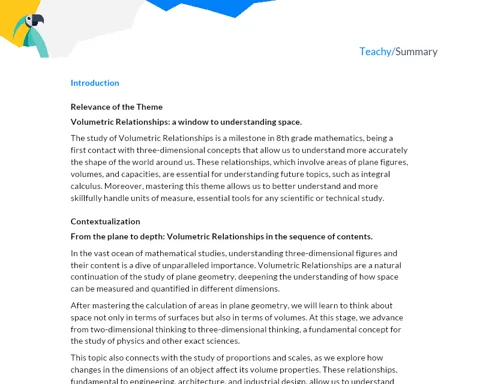Introduction
Relevance of the Topic
Mathematical operations form the foundation of our numerical understanding and are the basis for more complex calculations. A correct understanding of the order of operations is vital to ensure the accuracy and consistency of the results obtained. Lack of clarity about this order can lead to mistakes that can be harmful.
Contextualization
The order of operations is one of the main topics in the 6th-grade mathematics curriculum of Elementary School. It is crucial to understand how mathematical operations relate to each other and how the result of a numerical expression can be determined. This skill becomes especially important when students start working with more complex operations involving decimals and fractions.
Theoretical Development
Components
-
P.E.M.D.A.S: The acronym P.E.M.D.A.S, in Portuguese, represents the order of operations - Parentheses, Exponents, Multiplication and Division (from left to right), and Addition and Subtraction (from left to right). P.E.M.D.A.S is our guide to executing a list or series of mathematical operations in a logical and consistent manner.
-
Parentheses: Parentheses have the highest priority in the order of operations. Any operation included in parentheses must be performed before any other operation is executed. If there are parentheses within other parentheses, the process should always start with the innermost operations.
-
Exponents: Any number or expression with an exponent must be resolved before moving forward. In the case of an expression with multiple exponents, the process should be carried out from top to bottom.
-
Multiplication and Division: After solving all operations in parentheses and with exponents, the next step is multiplication and division. They are solved from left to right, unless there is an exponent that affects the order.
-
Addition and Subtraction: The last step in the order of operations is addition and subtraction. Similar to multiplication and division, addition and subtraction are solved from left to right, unless there is a more prioritized operation.
Key Terms
-
Order of Precedence: Defines the priority that each mathematical operation has over the others when combined in an expression. It is the basis for understanding and applying the order of operations.
-
Numerical Expression: Combination of numbers, operations, and parentheses that can be simplified to obtain a numerical value.
-
Number Grouping: Refers to the ability to group numbers, either using parentheses or simply writing the numbers close to each other. This grouping serves to change the order in which operations are performed, according to the order of operations.
Examples and Cases
-
Example 1: Consider the numerical expression 4 + 6 x 2. The correct procedure would be to multiply 6 by 2 (resulting in 12) and then add 4, obtaining 16. However, if the addition were performed before the multiplication, the result would be 20, demonstrating the importance of correctly applying the order of operations.
-
Example 2: Consider the numerical expression 18 - (4 + 2) x 3. According to the order of operations, what is inside the parentheses must be resolved first, resulting in 18 - 6 x 3. The next step would be multiplication, resulting in 18 - 18. Finally, subtraction is performed, producing the final result of 0.
-
Example 3: In the case of a more complex expression, such as 10 - (2 x 3 + (10 ÷ 5)), the order of operations is applied in several steps. First, we solve the subtraction within the parentheses, 10 - (2 x 3 + 2). Then, the multiplication within the parentheses, 10 - (6 + 2). Finally, the addition is performed within the parentheses, resulting in 10 - 8 and, therefore, in 2.
Detailed Summary
Key Points
-
Importance of P.E.M.D.A.S: The P.E.M.D.A.S method is an important tool to ensure the correct order of operations when solving numerical expressions. It reminds us that parentheses, exponents, multiplication, and division take precedence over addition and subtraction.
-
Dominance of Parentheses: Parentheses have the highest level of priority in the order of operations. Operations within parentheses must always be performed first, regardless of what they are. If there are parentheses within other parentheses, the process follows from inside to outside.
-
Consideration of Exponents, Multiplication, and Division: After solving the operations within parentheses, we should focus on exponents, followed by multiplication and division, if any. When there are multiple of these operations, they are performed from left to right.
-
Finally, Addition and Subtraction: Addition and subtraction are the last step in the order of operations. Similar to multiplication and division, if there are multiple of these operations, they are done from left to right.
Conclusions
-
Accuracy of Calculations: Correctly applying the order of operations ensures that our calculations generate precise and consistent results. Failure to pay attention to the order of operations can result in errors.
-
Flexibility of Expressions: Numerical expressions can be written in various ways, but the order of operations remains the same. Changing the order of operations can result in a completely different result.
-
Constant Practice: Regular practice of complex numerical expressions with the order of operations enhances the understanding and application of this concept.
Exercises
- Simplify the expression: 20 - (4 + 2 x 3)
- Solve the expression: 10 - 3 x 2 + 4
- Find the value of x in the equation: 2 x (7 - x) = 10 - 2x



